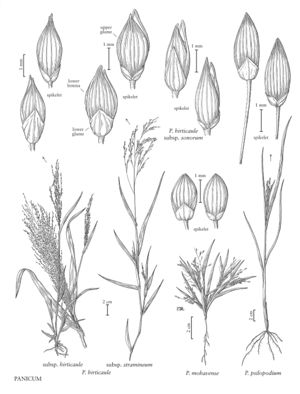Difference between revisions of "Panicum mohavense"
FNA>Volume Importer |
imported>Volume Importer |
||
| (2 intermediate revisions by the same user not shown) | |||
| Line 4: | Line 4: | ||
|publications= | |publications= | ||
|common_names=Mohave witchgrass | |common_names=Mohave witchgrass | ||
| + | |special_status={{Treatment/ID/Special_status | ||
| + | |code=E | ||
| + | |label=Endemic | ||
| + | }} | ||
|basionyms= | |basionyms= | ||
|synonyms= | |synonyms= | ||
| Line 38: | Line 42: | ||
|publication title= | |publication title= | ||
|publication year= | |publication year= | ||
| − | |special status= | + | |special status=Endemic |
| − | |source xml=https:// | + | |source xml=https://bitbucket.org/aafc-mbb/fna-data-curation/src/200273ad09963decb8fc72550212de541d86569d/coarse_grained_fna_xml/V25/V25_1243.xml |
|subfamily=Poaceae subfam. Panicoideae | |subfamily=Poaceae subfam. Panicoideae | ||
|tribe=Poaceae tribe Paniceae | |tribe=Poaceae tribe Paniceae | ||
Latest revision as of 17:56, 11 May 2021
Plants annual. Culms 2-8 cm, erect-spreading; nodes 1-2, hispid; internodes pilose, hairs papillose-based. Sheaths rounded, much longer than the internodes, with prominent veins, hispid, hairs papillose-based; ligules 0.2-0.4 mm, membranous, ciliate; blades 1-4 cm long, 1-3 mm wide, flat or involute apically, glabrous basally, margins ciliate, cilia papillose-based. Panicles congested, partially included in the sheaths, less than 1.5 times longer than wide; branches ascending, narrow; primary branches appressed to the main axes, secondary branches and pedicels attached to the distal 2/3; pedicels appressed, 1-2 mm. Spikelets 2-2.2 mm long, 1-1.3 mm wide, plump-ellipsoid, glabrous. Lower glumes 1.2-1.3 mm, acute to attenuate; upper glumes and lower lemmas 2-2.2 mm, 7-9-veined, apices purplish, acute; lower florets sterile; lower paleas 0.2-0.4 mm; upper florets 1.4-1.8 mm long, about 1 mm wide, broadly ovoid.
Discussion
Panicum mohavense is known only from arid limestone terraces in Arizona and New Mexico.
Selected References
None.
